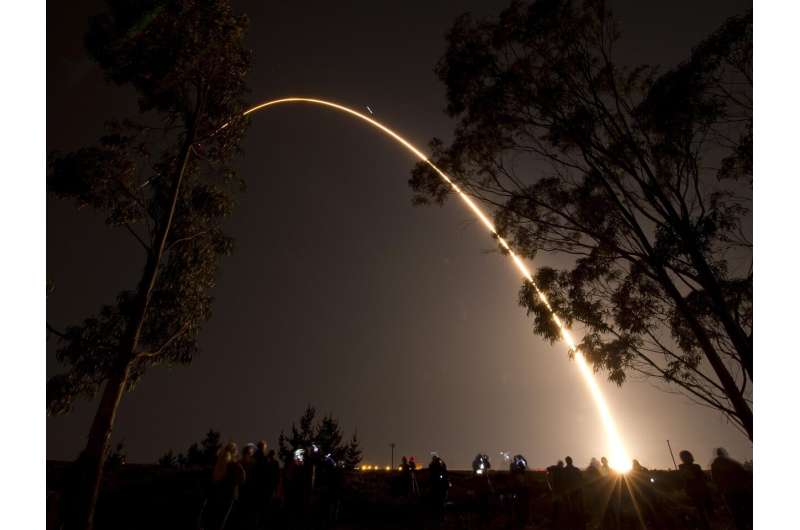This article has been reviewed according to Science X's editorial process and policies. Editors have highlighted the following attributes while ensuring the content's credibility:
fact-checked
reputable news agency
proofread
Fixes needed before first Vulcan Centaur launch

There's still work to be done, but United Launch Alliance has announced a path forward to finally get its new Vulcan Centaur rocket to its first launch.
The company sent an update Saturday announcing it had figured out what went wrong, and what needs fixing at its Alabama test facility that resulted in a fireball that damaged a test article of the Centaur V upper stage this spring.
"Centaur's thin-walled pressure stabilized tanks require minor reinforcement at the top of the forward dome prior to flight," the company stated in a press release.
That means the Centaur currently mated to the Vulcan first stage at Cape Canaveral Space Force Station that is tapped to fly on that rocket's first mission has to head back to Alabama to get that reinforcement.
The first and second stages recently completed a Flight Readiness Firing test at Canaveral's Space Launch Complex 41, and ULA said results of that hot fire hit all of the test objectives.
But now teams will de-stack the combined rocket and send Centaur V to ULA's Decatur, Alabama facility for the fix while the first-stage booster will be stored at ULA's Horizontal Integration Facility at Canaveral waiting for its return.
Just sending Centaur back for the fix isn't the only hurdle before the first launch, though.
What ULA called a "structural test stand anomaly" also damaged the facility at Marshall Space Flight Center in Huntsville, Alabama, on March 29, and there are more tests that need to be performed before ULA will let Vulcan fly.
"We need to repair the stand, whatever it takes to do that," said David McFarland, the ULA Launch Operations Chief Engineer and Anomaly Lead. "But we're looking at, are there alternatives to where we actually do some of the tests? So there's a lot to be established and how we get to the point where our validated testing is completed."
Once ULA determines where the remaining tests can be performed, the company also needs to pick one of the several Centaur V upper stages already in production to complete the testing.
Just how many more tests are needed is unclear, but ULA had stated it was in the latter half of upper stage testing when the anomaly threw progress off track in March.
That delay has meant a May 4 target of the first mission dubbed Certification-1 had to be pushed, and while ULA President and CEO Tory Bruno in May said teams could be aiming for June or July, no new launch date has been set.
"We are going to take the time necessary to do that properly, and so that we have the least amount of risk of proceeding to the first launch," McFarland said.
The Vulcan Centaur is ULA's replacement for the Atlas V and Delta IV rockets that remain in its stable.
The second-to-last Delta IV Heavy made its successful launch on Thursday on a mission for the National Reconnaissance Office from Cape Canaveral. That was ULA's first launch of the year as all of its rocket plans have faced hurdles in 2023.
That includes the delay of an Atlas V with Boeing's CST-100 Starliner that was aiming for a July launch with its first crew on a test flight to the International Space Station. Boeing announced issues it found on Starliner, though, that need fixing, and no new target launch has been declared for that mission either.
When Vulcan Centaur does get the go for launch, it will be flying up private company Astrobotic's lunar lander Peregrine that's headed to the moon. Also flying are the first two test satellites for Amazon's Project Kuiper, a planned massive constellation of internet satellites that will compete with SpaceX's Starlink constellation.
Project Kuiper is the thing that will keep Vulcan Centaur busy over the next five years, along with Department of Defense missions and launches of Sierra Space's Dream Chaser spacecraft.
Amazon, which also bought up the remaining Atlas V rockets, has contracted with ULA for 38 Vulcan launches of its satellites.
The demand means ULA looks to get Vulcan up to a pace of one launch about every two weeks.
"The team has been working fervently on Vulcan processing," McFarland said. "There is a lot of stuff happening in the background while all of these things are being worked on. … Within the next couple of years we'll be increasing our launch cadence quite a bit."
2023 Orlando Sentinel. Distributed by Tribune Content Agency, LLC




















